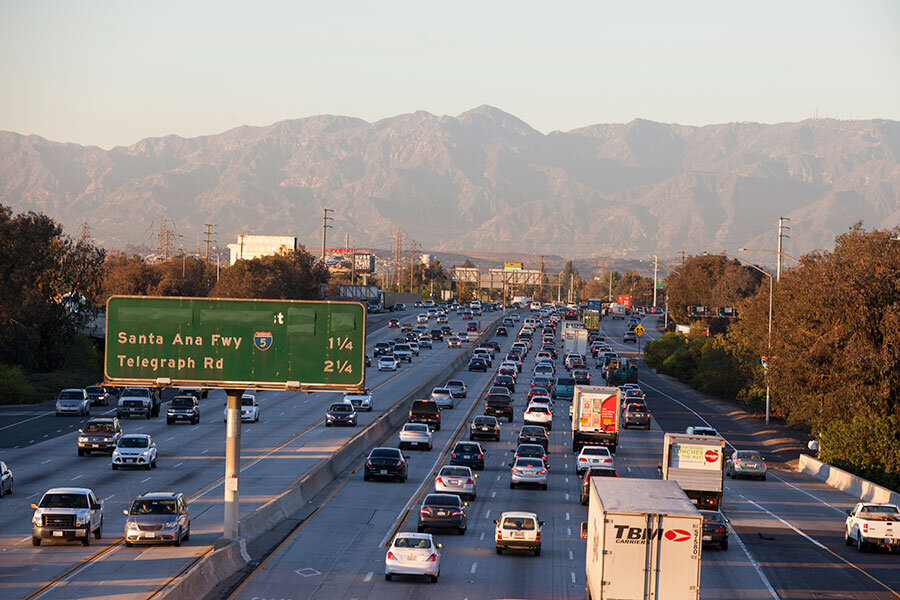Did California try to go too far in fight against climate change?
Loading...
Joe Del Bosque, owner of Del Bosque Farms on the west side of the San Joaquin Valley in central California, is keeping half an eye on the latest climate legislation making its way through the statehouse.
For decades, the Golden State has been at the vanguard of America’s fight against climate change, with state lawmakers working in a bipartisan fashion to turn a state renowned for smog and traffic jams to one of solar panels and electric cars.
Mr. Del Bosque doesn’t necessarily mind all this, but this latest bill – Senate Bill 350 – has him worried. Initially, it was called the "50-50-50" bill, requiring 50 percent renewable power, 50 percent more energy efficiency in buildings, and 50 percent less petroleum use in cars and trucks – all by 2030.
Now, the last "50" has been dropped, and the concerns of folks like Del Bosque have been a major reason.
Environmentalists blame the setback on the energy industry. But others suggest that the 50 percent petroleum target might define an upper limit for what even green states like California are willing to do on climate change. In particular, if policies threaten to dramatically reshape driving habits – or force people to buy cars they don't want – there can be blowback.
In that way, the travails of the 50-50-50 bill, seen as a potential national model, could reverberate nationwide.
To hit the aggressive petroleum targets, large numbers of Californians would have had to switch to electric cars, suggested John German of the International Council on Clean Transportation to Grist, a news website that tracks climate change issues. They also would have had to abandon the American practice of holding onto cars for an average of 11 years, he said.
For Del Bosque, this seemed to be going too far.
“It’s going to be a hardship for the whole state really,” he says. “We in the Central Valley, we think that there’s going to be some collateral damage from this thing. There’s going to be hardship caused, especially to poor people, people like our employees.”
On this issue, it appears that the energy industry's message stuck. One commercial financed by the Western States Petroleum Association shows a man standing in front of a car. “This law will limit how often we can drive our own cars,” he says.
He adds that the state would be “collecting and monitoring our personal driving habits,” and that “regulators will be able to penalize and fine us if we drive too much or use too much gas.”
While the initial version of the “50-50-50” bill passed the Democratic-controlled Senate earlier this year, the petroleum reduction provision was dropped after encountering opposition in the state Assembly from Republicans and moderate Democrats.
California has gotten used to breaking down walls when it comes to climate policy, but it hasn’t necessarily gotten used to such a battering while doing so. The state first voted to cut its greenhouse gas emissions back in 2006, under Republican Gov. Arnold Schwarzenegger. When a 2010 ballot initiative called for the suspension of the emission cuts, 62 percent of voters rejected it. In 2012, President Obama took the state’s fuel economy program and applied it to a national fuel efficiency standard.
But defeating the new bill was a top priority for the energy industry.
Timothy O’Connor, director of the Environmental Defense Fund’s California Climate Initiative, has spent a decade working in the California statehouse and says the fossil fuel industry has spent $38 million on legislation and campaigns in California in the past year.
“I’ve never seen the amount of commercials, lobbying, and expenditures of this type in my 10 years at the legislature,” he says.
On the petroleum measure, it appears to have worked. Kevin de León, the leader of the California Senate and co-author of the bill, conceded to reporters that he did not have enough votes to pass the original bill. But now that the petroleum provision has been dropped, Henry Perea, a Democratic assemblyman who led opposition to SB 350, told The New York Times that he would support the measure.
Environmentalists are disappointed about the loss of the petroleum provision, but they're pleased that the other two appear likely to survive. And the petroleum target could still be met through a number of different programs and policies already in place across the state, says Susan Shaheen, director of Innovative Mobility Research at the University of California, Berkeley’s Institute for Transportation Studies.
The Natural Resources Defense Council estimates that the state is already halfway to reaching the 50 percent petroleum reduction goal.
A law passed in 2008 enables regions and municipalities to improve land use so people spend less time commuting, and the state’s Low Carbon Fuel Standard, enacted in 2007, has helped increase the penetration of renewable fuels by 20 percent compared to 2010.
“There’s nothing here that stops [other] states going forward with clean transportation programs, which is the bread and butter of not just reducing carbon emissions but cutting oil dependency,” says Simon Mui, director of the NRDC’s California Clean Vehicle and Fuels Program.
In the San Joaquin Valley, Del Bosque says that the petroleum reduction provision was “the most important part” of the bill for him, but he says he’s going to do more research on the rest of it now.
“I’m for becoming more sustainable and being a little more climate change friendly,” he says, “but I don’t want to starve for that, and I don’t want people to lose their jobs over it.”






